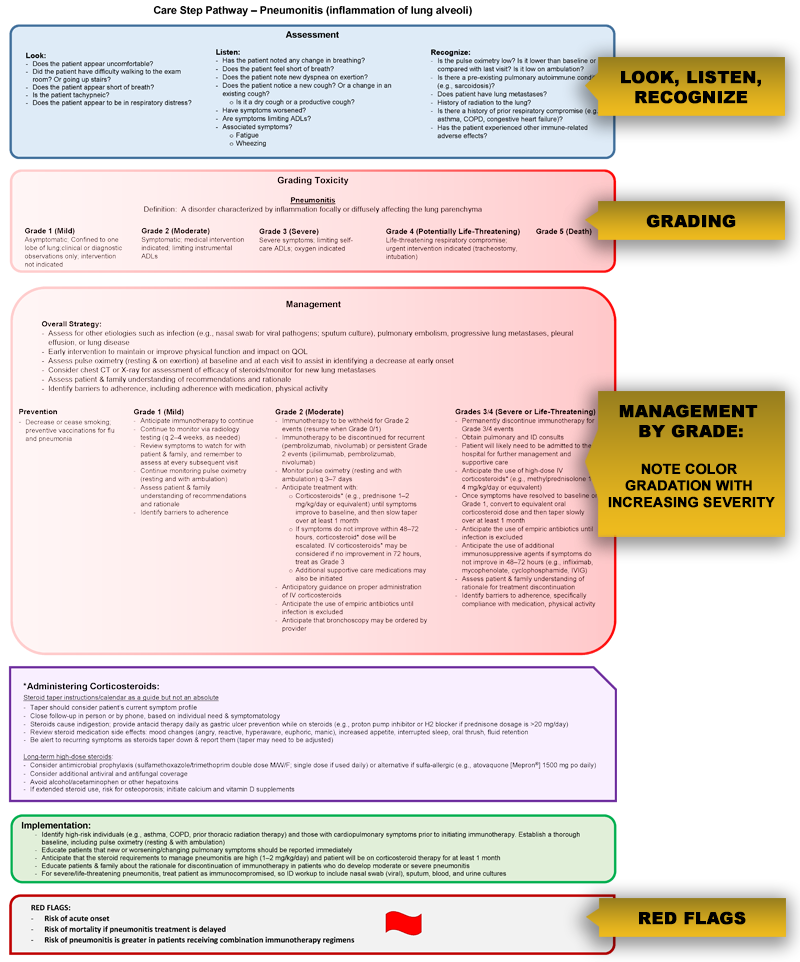Welcome to the Care Step Pathways
UPDATED! The Care Step Pathways (CSPs) have been updated in 2023 to reflect the latest management strategies from ASCO, the NCCN, and various organ-specific working groups for immune-related adverse event grading and management.
This section provides stand-alone Care-Step Pathways (CSPs). CSPs are innovative and practical tools to address notable toxicities unique or notable with checkpoint inhibitor therapies. The CSPs, first introduced in the Melanoma Nursing Initiative, use specialized formats and components to provide comprehensive assessment and management strategies in a visually appealing and easy-to-use format. The CSPs are inclusive. They contain specific information for each of the FDA-approved checkpoint inhibitors and combinations addressed in this website and are relevant across tumor types. Intralesional therapy has its own CSP.
As shown in the figure, the “Look, Listen, and Recognize” section guides oncology care providers to a specific set of symptom-related questions to ask the patient and/or caregiver as well as additional information to consider/review as part of the assessment. The information obtained from this focused assessment will direct the appropriate management and provider interventions. Next is the grading section. Wherever possible, we used the Common Terminology (or Toxicity) Criteria for Adverse Events (CTCAE) for grading, which allows for interpretation of subjective symptoms in an objective manner. These criteria employ a grading system—from 1 (mild) to 4 (Life-threatening)—to represent that toxicity defined by specific parameters according to the organ system involved. In some cases, these CTCAE criteria are in evolution, so other sources were consulted to assign grading and classification.
Finally, as shown in the figure, the CSPs address management. Here, our focus is both on the practical, nurse-led interventions that healthcare providers can and should undertake as well as anticipatory guidance regarding drug holds/discontinuations, dosage adjustments, and management strategies. The color scheme used in the management sections (light pink to dark red with increasing severity) helps reemphasize the treatment-by-grade approach. Moreover, red flags serve as a reminder to intervene rapidly at the recognition of signs/symptoms of more serious, life-threatening manifestations of these AEs.
Again, all of these CSPs have been reviewed and updated to address relevant recommendations from the NCCN, ASCO/SITC and additional irAE-specific working groups.
Below are the 13 CSPs for immune checkpoint inhibitors, 2 for bispecific T-cell engager therapy, as well as 1 for intralesional therapy.
We hope that you find these CSPs useful in your efforts to optimize care for your patients receiving immune checkpoint inhibitors or intralesional therapy.
List of CSPs
For Immunotherapy (Checkpoint Inhibitors):
YERVOY® (ipilimumab)
LIBTAYO® (cemiplimab)
OPDIVO® (nivolumab)
OPDUALAG™ (nivolumab)/(relatlimab)
KEYTRUDA® (pembrolizumab)
OPDIVO® (nivolumab)/YERVOY® (ipilimumab)
- Skin Toxicities – View Online
- Gastrointestinal Toxicities (Diarrhea and Colitis) – View Online
- Thyroid Dysfunction (Formerly Thyroiditis) – View Online
- Hepatotoxicity – View Online
- Hypophysitis – View Online
- Adrenal Insufficiency, primary – View Online
- Hyperglycemia (Formerly Diabetes) – View Online
- Pneumonitis – View Online
- Inflammatory Arthritis (Formerly Arthralgia/Arthritis) – View Online
- Mucositis/Xerostomia – View Online
- Myocarditis – View Online
- Neuropathy – View Online
- Renal Toxicity (Formerly Nephritis) – View Online
For Bispecific T-cell Engager Therapy:
KIMMTRAK® (Tebentafusp-tebn)
- Cytokine Release Syndrome – View Online
- Skin Toxicities – View Online
For Intralesional Therapy:
IMLYGIC® (talimogene laherparepvec; T-VEC)
- Overall Side Effects – View Online

